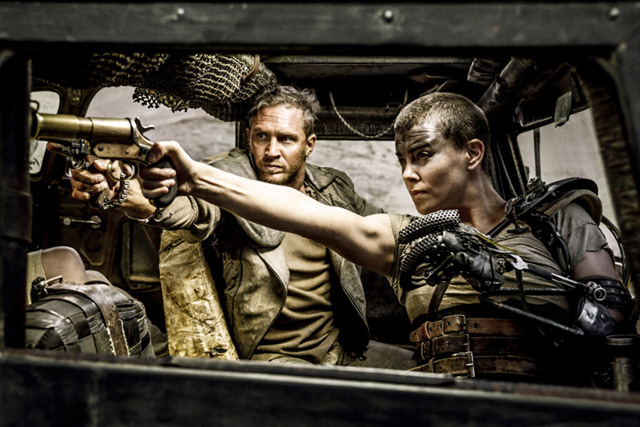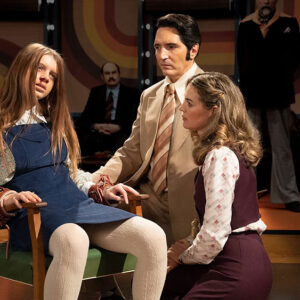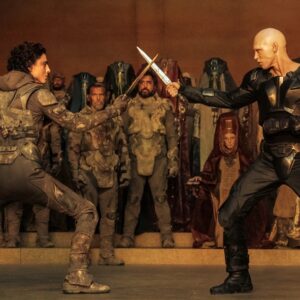One Filmmaker’s Take On ‘Mad Max: Fury Road’

(Ed. Note: Alex Valderana is the showrunner/executive producer/head writer of the web series Nightwing: Escalation. He is also a contributing photographer to Nerd Caliber under his Alex Valderana Photography name. As a filmmaker, we asked him to review Mad Max: Fury Road.)
I grew up not being a big fan of the Mad Max saga. I was always more of a Star Wars, Godzilla, Batman guy. That much is obvious. But damn. After seeing Mad Max: Fury Road, I have to wonder what I was missing out on in the more formative years of my life.
One look at director George Miller’s list of credits and you’ll find that his last few films were the last two Happy Feet films and 1998’s Babe: Pig In The City. You look early on in his work during the ’80’s and you see the emergence of Mad Max in 1979, followed in 1981 by it’s sequel The Road Warrior and then finally in 1985 with Mad Max: Beyond Thunderdome. One would also look at his age of seventy and think that “Man, this guy is one of those directors who found success in the ’70’s and ’80’s and has an occasional hit nowadays, if that.” But man oh man. You’d be wrong.
Out of completely left field it seems, after almost 20 years, 70-year old Mr. Miller returns to show all the kids how it’s done. Fury Road is an absolute thrill ride, exhilarating from first frame to the last, a film that’s vibrant, energetic and different than the action films that have dominated the last few decades. It was a definite breath of fresh air in my eyes, eyes used to being soaked in explosions, gratuitous T&A shots, insulting-to-listen-to dialogue and awful overly complicated plotlines which you’ll see in most films directed by or produced by Michael Bay. Fury Road tells a simple story, which in a nutshell, is a group of people moving from point A to point B, with a group of people in pursuit of them, for their own motivations. But upon closer inspection, it’s a look into a world where men dominate, where men have destroyed and scorched the Earth (“Who killed the world?”) and where females are a minority, fighting for their own place in the world. And that’s just scratching the surface. An in-depth analysis would take up more than a few pages’ reading.

So let’s keep it simple. Fury Road is synopsized on IMDB as: “In a stark desert landscape where humanity is broken, two rebels just might be able to restore order: Max, a man of action and of few words, and Furiosa, a woman of action who is looking to make it back to her childhood homeland.” And as I mentioned, its plotline, on the surface, isn’t super complicated. There’s not scene after scene of quiet characterization. The film is breathtakingly shot and captured by cinematographer John Seale, who, like Miller, has a very mixed bag of previous work, ranging from acclaimed films like Rain Man, Gorillas in the Mist, and The English Patient to more recent films Poseidon, Spanglish, The Tourist and of course the epic Prince of Persia: The Sands of Time (sarcasm). The action in Fury Road is 80 percent practically captured, which in and of itself is a feat. Looking at what went into the film, it’s an absolute miracle that it even got made. Think of the budget going into it. Think of the details of being cast in it. You’re gonna be spending a bunch of months in the blazing hot desert. No Internet, no Wi-Fi, no Facebooking or Instagramming. Tom Hardy, who portrays Max, was even quoted as apologizing to George Miller at Cannes. Hardy apparently had been a bit difficult to work with, being unaware of exactly what the scope of story Miller was telling. After seeing the film, Hardy was a true believer.
One of the most significant things to take away from a viewing of Fury Road, or at least what I walked away with, was how different it was. And what I mean by that was that (SPOILERS) Max was not the narrative center of the tale. I’ll put it on front street here: this is not Max’s story. Max is there to help facilitate things, of course, and to help get Imperator Furiosa (Charlize Theron) and her band of rebels out of some muddy waters, but there debatably isn’t anything Furiosa couldn’t have handled on her lonesome without Max’s help.
Piggybacking off that point, many have praised this film as feminist. Did it pass the Bechdel test? For those who don’t know, the Bechdel test is a term used in films to call attention to gender inequality. For a film to pass the test, it must (1) have at least two women in it who (2) talk to one another and finally (3) talk about something other than a man. Does the female lead star have more lines than the male? Yes. Now, is it feminist? Does it strive to put women at the front of its narrative in an engaging, different and positive way? Yes and no. When Max first stumbles upon Furiosa’s group, the statuesque group of ladies are dousing themselves with a hose of water from their rig, orange glow of sunlight at their backs and sides. The audience I first saw the film in let out a collective murmur of appreciation. Even some laughs. And a disappointed, annoyed look from the girlfriend of a couple on a date next to me. Did it seem like a frame from a porn parody of Mad Max? Maybe. The shot almost seemed like it came out of a Michael Bay movie (not film, he doesn’t make those). Does (SPOILERS) Max kind of “I had a great time, gal, but I’m not gonna give you a call after our first date” moment with Furiosa at the end? Is the film oversexualized? Are the women, even Furiosa at points, glorified damsels in distress? Was the love interest subplot absolutely necessitated? Does Furiosa need Max’s help? Toward the climax, does she follow his lead when her journey is pointed out as a bit illogical, and he has a different and maybe safer strategy to victory? Is Nightwing: Escalation Season 1 a horrific waste of one’s time? This is a whole ‘nother debatable topic, one that could be even relocated to a whole ‘nother article. But stay calm, kids. This is a review!
The motivations of the characters are simple. The villainous Immortan Joe (Hugh Keays-Byrne, who also portrayed Toecutter in the ’79 original film) wants his ladies back. He wants his purest women, his breeders, the Five Wives, back intact, and the traitorous Furiosa dead or alive, made to suffer for her betrayal. Furiosa wants to get the Five Wives to safety, to the Green Place, an area they can reclaim and find a bit of peace. Max at first seems to want liberation, but as time goes on, chooses to aide Furiosa in her quest for hope. Immortan Joe has his cult-like followers the War Boys, crazed individuals who believe Joe is a god leading them to a divine afterlife in Valhalla after leading them into epic battles.
And make no mistake. Every action scene in this film is breathtaking. They will do things rarely seen in cinema. And aside from moving some mountains to the side and throwing in dunes of sand instead, adding some massive sandstorms, eighty percent of the action was practical, not digital. In this day and age of all things digital, that is a true rarity. And it’s that real feeling that reinforces the passion behind the film, the passion that inspires people to believe. Upon first seeing the opening scenes in Immortan Joe’s Citadel, you see hundreds upon hundreds of extras dressed as the lower class, and the higher class, adorning the walls and ground floor of the Citadel. When was the last time you saw that amount of people rendered on-screen — except they weren’t rendered by a computer program. They were real extras. Um, Lawrence of Arabia, maybe? That alone is one of those sights that aid the film. For all that sacrifice of those making this flick, the least one can do is give them your $15 or $20 for 120 minutes of your time on this Earth.
All in all, I’ve seen this film five times. Once on a date, once with a friend, another with another friend, and so on and so forth. The soundtrack composed by Junkie XL a.k.a. Tom Holkenborg is incredible. I downloaded it the night I saw the film. Master D.P. John Seale’s cinematography, sweeping. The dialogue, spare and meaningful. There isn’t one dishonest performance in the entire film, hell, Miller even manages to pull a strong performance out of model/actress Rosie Huntington-Whiteley, who portrays The Splendid Angharad, Immortan Joe’s most prized (and pregnant) Wife. Remember her? No? She was Shia LeBouf’s Megan Fox-fill-in girlfriend in Transformers: Dark of the Moon. Now remember?
Mad Max: Fury Road leaves you wanting more. And I don’t know about you, but I want to know more about the Coma-Doof Warrior, the blind guitarist draped in red who plays the guitar like his life is dependent on it, charging with the Wild Boys and Immortan Joe into battle to intimidate their foes. I see future cosplays. Mad Max cosplays everywhere. Five stars from this filmmaker guy, the Valdman. Signing out.



